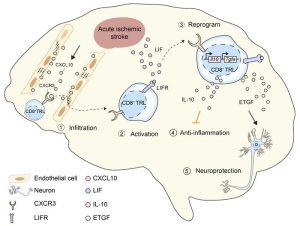In a recent paper, researchers have found that CD8+ regulatory-like T cells release neuroprotective molecules in the brain following a stroke, which may limit inflammation and subsequent brain damage (Figure 1). These protective effects were observed in ischemic stroke in mice.
In this paper, the researchers described a subset of CD8+ regulatory-like T cells which act as the first phase/response to a stroke. These cells are found to migrate to the site of ischemic injury within 24 hours after a stroke in response to various hormonal signals. From there they release hormones and molecules involved in several neuroprotective functions. Importantly, the development of CD8+ TRLs as a stable treatment could provide an effective therapeutic for stroke treatment.
This paper described the process of which CD8+TRLs enter the brain much, which is faster than any other regulatory immune cells. Researchers reduced CD8+ TRLs from the bloodstream of mice whom had a stroke and found that the size of the brain region affected by ischemia expanded by 50% compared to animals whose CD8+TRL levels remained intact.
In their own words:
“In sum, our results suggest that the early infiltration of CD8+ TRLs naturally limits infarct expansion in the ischemic brain and that adoptive transfer of CD8+ TRLs offers a potentially novel immunotherapy for stroke. This study sheds further light on mechanisms underlying the reduction of acute ischemic brain injury by CD8+ TRLs and the resulting functional recovery, thereby improving our mechanistic understanding of immunomodulation of stroke outcomes and accelerating breakthroughs against an intractable brain disorder that has defied effective treatment.”
Journal article: Cai, W., et al., 2022. Neuroprotection against ischemic stroke requires a specific class of early responder T cells in mice. Journal of Clinical Investigation.
Summary by Stefan Botha











